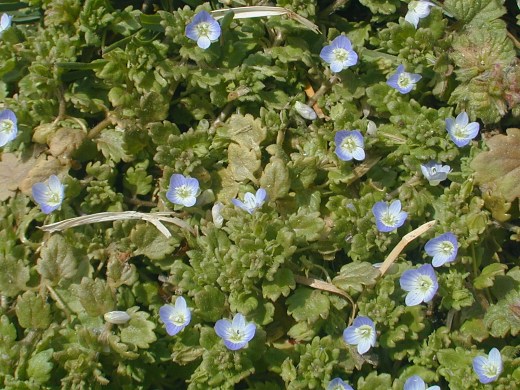Description: This plant is a winter or spring annual that becomes 2-10" long, branching occasionally. This plant begins to flower while it is very short and erect, but it sprawls across the ground as it becomes longer and more mature. A typical plant branches into many side stems near the base, while the side stems themselves are largely unbranched. These stems are round, hairy, and slightly fleshy. The lower leaves are opposite along the stem; they have short petioles. They are typically about 1/3" (8 mm.) long and 1/4" (6 mm.) across, oval or oval-orbicular in shape, and crenate-dentate along the margins. The upper leaves of more mature plants usually alternate along the stems, and they are nearly sessile. Like the stems, the leaves have a slightly fleshy texture with scattered hairs across the surface.

From the axil of
each upper leaf, there develops a single flower about 1/4" (6 mm.)
across on a
short pedicel (about 1/4" or 6 mm. long). Each flower has a short
corolla with 4
spreading lobes, the lowest one being somewhat smaller than the rest.
This corolla is light blue-violet, becoming white near the throat, with
fine blue-violet lines that function as nectar guides to visiting
insects. The green calyx is divided into 4 lanceolate teeth that are
hairy and often unequal in size. At the throat of the corolla, there is
a white pistil and 2 stamens. This plant typically blooms during early
spring, and sporadically thereafter until summer. However, some plants
may bloom for a shorter period during the fall. The flowers are
replaced by tiny heart-shaped capsules that have 2 cells, each cell
containing several tiny seeds inside. These capsules are somewhat thick
and fleshy, and they are covered with fine glandular hairs. The root
system is fibrous and spreading. In open sunny areas, this plant often
form colonies by reseeding itself.
Cultivation:
Wayside Speedwell is found in open sunny areas that are mesic to dry.
It is not particular about soil characteristics, but it is often found
in poor soil that is compacted, gravelly, or sandy. Most growth occurs
during cool spring weather, and it appears to have few enemies. This
plant is among the earliest to bloom during the spring, and will set
seed before gardens are rototilled and fields are plowed. It can be
controlled using broadleaf herbicides, and will decline in abundance if
forced to compete with taller plants. Regular mowing is not effective
in controlling this low-growing plant.
Range & Habitat:
The adventive Wayside Speedwell has been reported from only a few
counties in
southern and east-central Illinois. However, it is undoubtedly more
common than official records indicate. This weedy little plant is
usually found in highly disturbed areas, such as roadside embankments,
lawns, and barren fields. It is native to Europe.
Faunal Associations:
Mainly small flies visit the flowers for nectar or pollen. Less common
visitors include Halictid bees and other small short-tongued bees.
Photographic Location:
Along a sidewalk on a lawn during early spring in Urbana, Illinois. The
photographed plants are just beginning to bloom and they are still
quite short.
Comments:
Wayside Speedwell has attractive blue-violet flowers when they are
viewed close-up, but they are usually overlooked because of their small
size. In addition to some native Veronica spp.,
there are many weedy Veronica spp. from Eurasia that can be difficult
to distinguish from each other. Wayside Speedwell has flowers about ¼"
across and pedicels that are about ¼" long. Other Veronica
spp. have smaller flowers and shorter pedicels (e.g., Veronica
arvensis), while other Veronica spp. have
larger flowers and longer pedicels (e.g., Veronica persica).
The heart-shaped seed capsules of Wayside Speedwell are more thick and
fleshy than those of other Veronica spp., and they
are covered with sticky glandular hairs (visible using 10x
magnification).